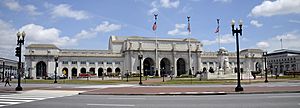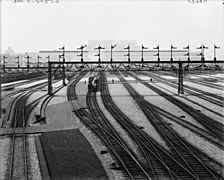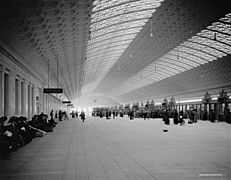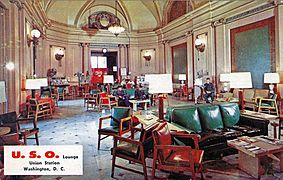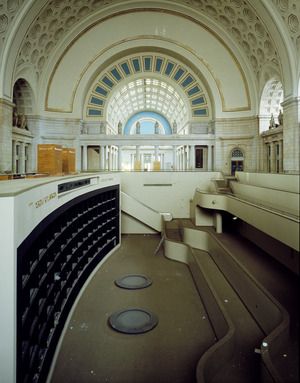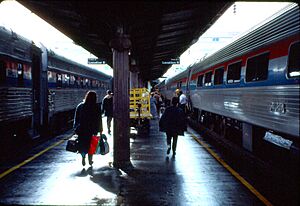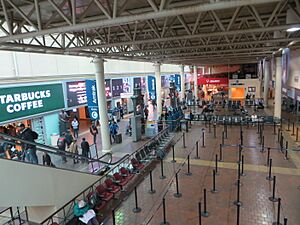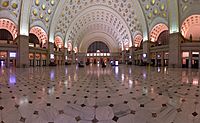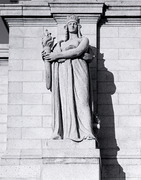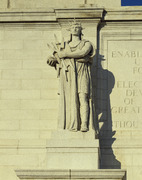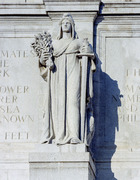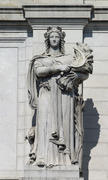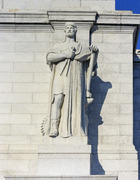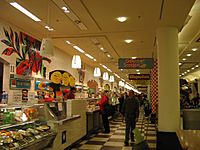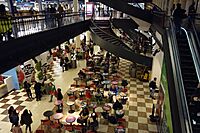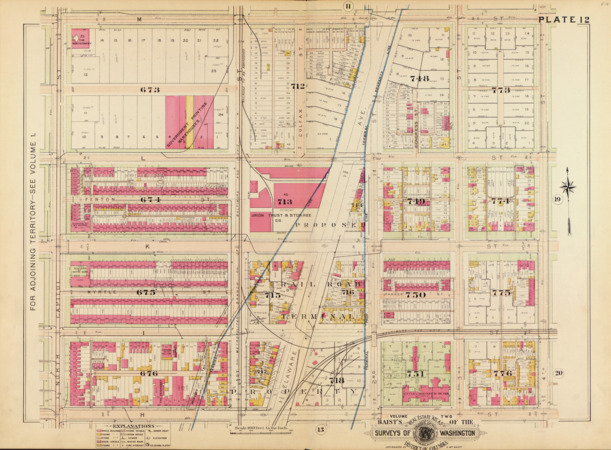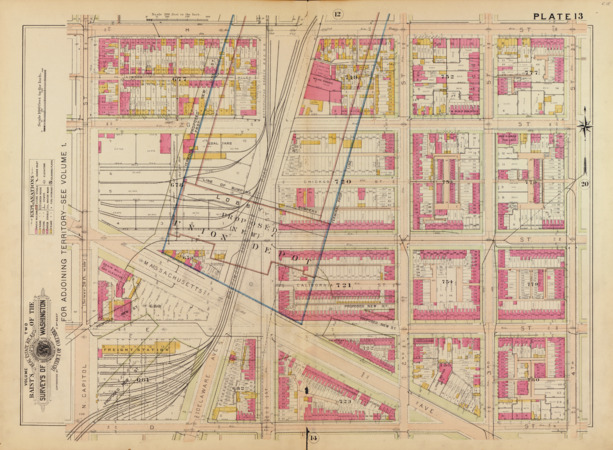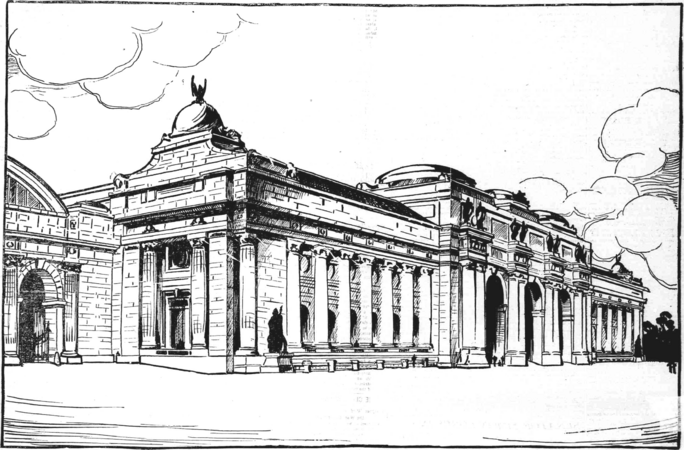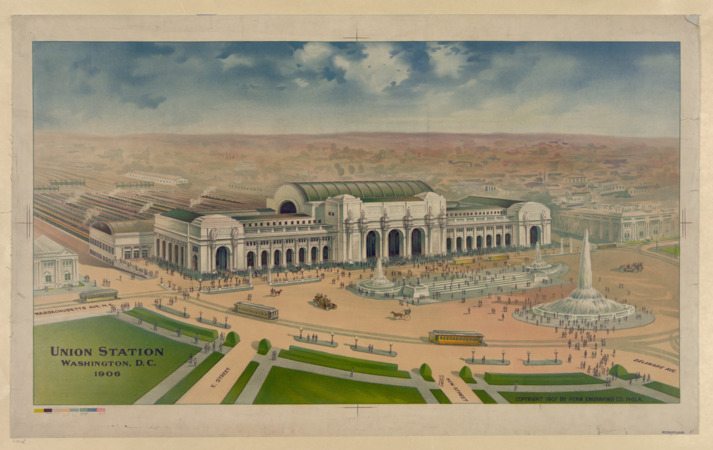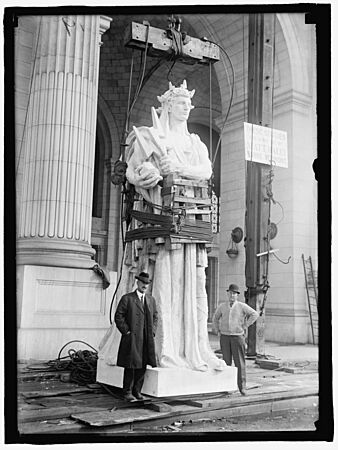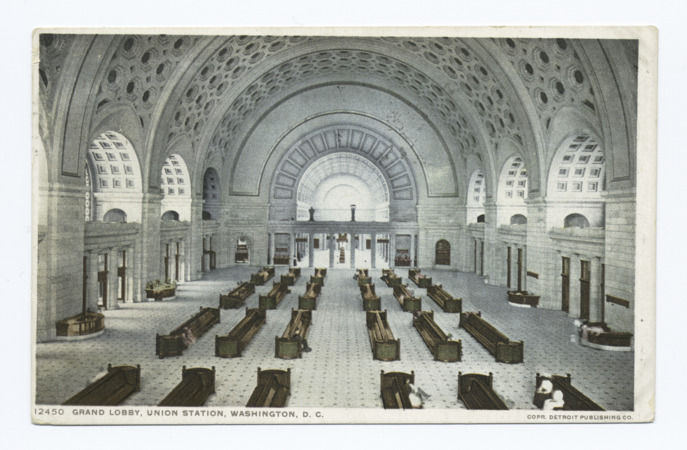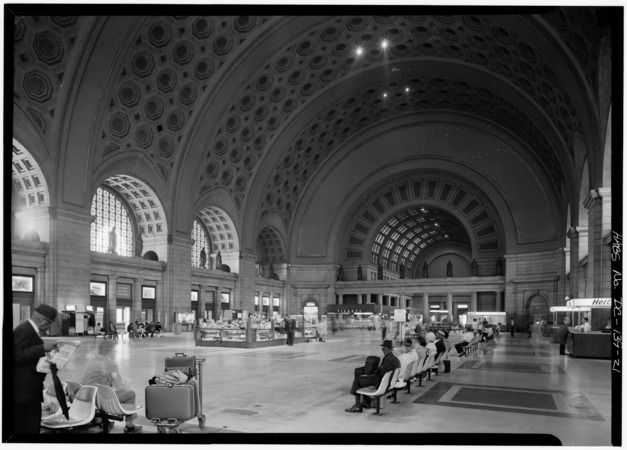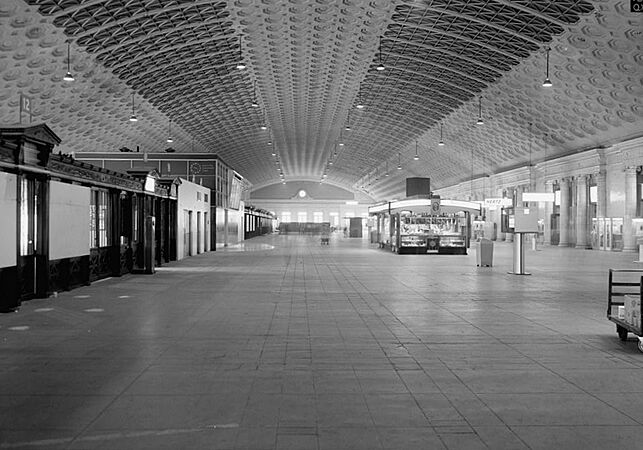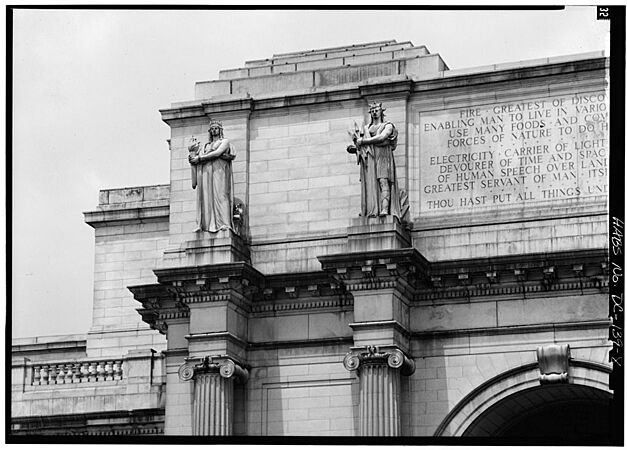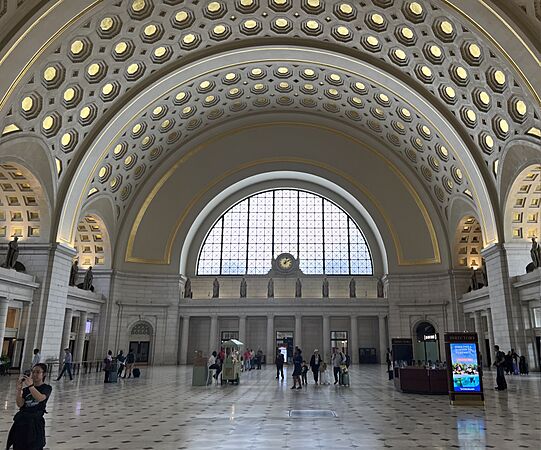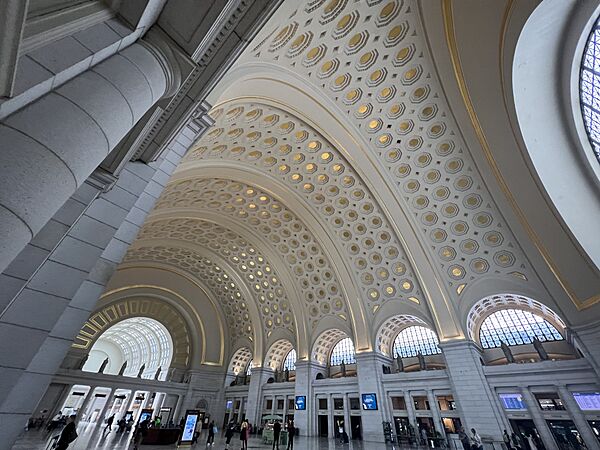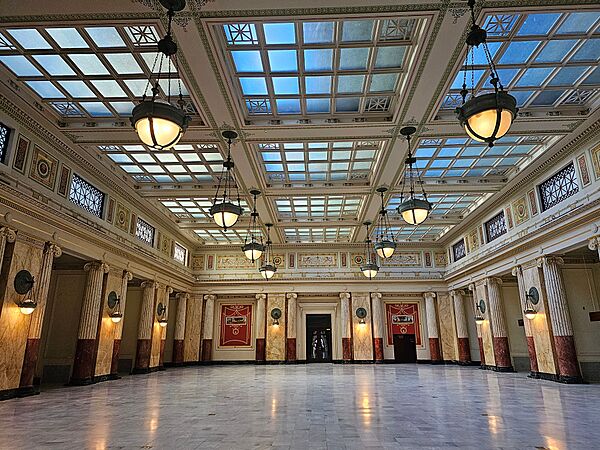Washington Union Station facts for kids
Quick facts for kids
Union Station
Washington, DC |
||||||||||||||||||||||||||||||||||||||||||||||||||||||||||||||||||||||||||||||||||||
|---|---|---|---|---|---|---|---|---|---|---|---|---|---|---|---|---|---|---|---|---|---|---|---|---|---|---|---|---|---|---|---|---|---|---|---|---|---|---|---|---|---|---|---|---|---|---|---|---|---|---|---|---|---|---|---|---|---|---|---|---|---|---|---|---|---|---|---|---|---|---|---|---|---|---|---|---|---|---|---|---|---|---|---|---|
| Amtrak, MARC and Virginia Railway Express station | ||||||||||||||||||||||||||||||||||||||||||||||||||||||||||||||||||||||||||||||||||||
|
Union Station in 2015
|
||||||||||||||||||||||||||||||||||||||||||||||||||||||||||||||||||||||||||||||||||||
| Location | 50 Massachusetts Avenue NE Washington, D.C. United States |
|||||||||||||||||||||||||||||||||||||||||||||||||||||||||||||||||||||||||||||||||||
| Coordinates | 38°53′50″N 77°00′23″W / 38.89731°N 77.00626°W | |||||||||||||||||||||||||||||||||||||||||||||||||||||||||||||||||||||||||||||||||||
| Owned by | United States Department of Transportation (station building and parking) Washington Terminal Company/Amtrak (platforms and tracks) Union Station Redevelopment Corp. leased to Ashkenazy Acquisition Corporation |
|||||||||||||||||||||||||||||||||||||||||||||||||||||||||||||||||||||||||||||||||||
| Operated by | Jones Lang LaSalle | |||||||||||||||||||||||||||||||||||||||||||||||||||||||||||||||||||||||||||||||||||
| Line(s) | Amtrak Northeast Corridor CSX RF&P Subdivision |
|||||||||||||||||||||||||||||||||||||||||||||||||||||||||||||||||||||||||||||||||||
| Platforms | 18 | |||||||||||||||||||||||||||||||||||||||||||||||||||||||||||||||||||||||||||||||||||
| Tracks | 22 | |||||||||||||||||||||||||||||||||||||||||||||||||||||||||||||||||||||||||||||||||||
| Train operators | Amtrak, MARC, VRE | |||||||||||||||||||||||||||||||||||||||||||||||||||||||||||||||||||||||||||||||||||
| Bus stands | located on the mezzanine level | |||||||||||||||||||||||||||||||||||||||||||||||||||||||||||||||||||||||||||||||||||
| Bus operators |
|
|||||||||||||||||||||||||||||||||||||||||||||||||||||||||||||||||||||||||||||||||||
| Connections | ||||||||||||||||||||||||||||||||||||||||||||||||||||||||||||||||||||||||||||||||||||
| Construction | ||||||||||||||||||||||||||||||||||||||||||||||||||||||||||||||||||||||||||||||||||||
| Parking | 2,448 spaces | |||||||||||||||||||||||||||||||||||||||||||||||||||||||||||||||||||||||||||||||||||
| Bicycle facilities | 180 | |||||||||||||||||||||||||||||||||||||||||||||||||||||||||||||||||||||||||||||||||||
| Other information | ||||||||||||||||||||||||||||||||||||||||||||||||||||||||||||||||||||||||||||||||||||
| Station code | Amtrak: WAS | |||||||||||||||||||||||||||||||||||||||||||||||||||||||||||||||||||||||||||||||||||
| IATA code | ZWU | |||||||||||||||||||||||||||||||||||||||||||||||||||||||||||||||||||||||||||||||||||
| Fare zone | 1 (VREX) | |||||||||||||||||||||||||||||||||||||||||||||||||||||||||||||||||||||||||||||||||||
| History | ||||||||||||||||||||||||||||||||||||||||||||||||||||||||||||||||||||||||||||||||||||
| Opened | 1908 | |||||||||||||||||||||||||||||||||||||||||||||||||||||||||||||||||||||||||||||||||||
| Rebuilt | 1981–1989 | |||||||||||||||||||||||||||||||||||||||||||||||||||||||||||||||||||||||||||||||||||
| Electrified | January 28, 1935 (ceremonial) February 10, 1935 (regular service) |
|||||||||||||||||||||||||||||||||||||||||||||||||||||||||||||||||||||||||||||||||||
| Traffic | ||||||||||||||||||||||||||||||||||||||||||||||||||||||||||||||||||||||||||||||||||||
| Passengers (FY2019) | 5,207,223 (Amtrak only) | |||||||||||||||||||||||||||||||||||||||||||||||||||||||||||||||||||||||||||||||||||
| Services | ||||||||||||||||||||||||||||||||||||||||||||||||||||||||||||||||||||||||||||||||||||
|
||||||||||||||||||||||||||||||||||||||||||||||||||||||||||||||||||||||||||||||||||||
|
||||||||||||||||||||||||||||||||||||||||||||||||||||||||||||||||||||||||||||||||||||
|
Washington D.C. Union Station
|
||||||||||||||||||||||||||||||||||||||||||||||||||||||||||||||||||||||||||||||||||||
| Lua error in Module:Location_map at line 420: attempt to index field 'wikibase' (a nil value). | ||||||||||||||||||||||||||||||||||||||||||||||||||||||||||||||||||||||||||||||||||||
| Built | 1908 | |||||||||||||||||||||||||||||||||||||||||||||||||||||||||||||||||||||||||||||||||||
| Architect | D.H. Burnham & Company (William Pierce Anderson, Daniel Burnham) | |||||||||||||||||||||||||||||||||||||||||||||||||||||||||||||||||||||||||||||||||||
| Architectural style | Classical, Beaux-Arts, among others | |||||||||||||||||||||||||||||||||||||||||||||||||||||||||||||||||||||||||||||||||||
| NRHP reference No. | 69000302 | |||||||||||||||||||||||||||||||||||||||||||||||||||||||||||||||||||||||||||||||||||
| Designated | March 24, 1969 | |||||||||||||||||||||||||||||||||||||||||||||||||||||||||||||||||||||||||||||||||||
Washington Union Station, often called Union Station, is a huge train station and a busy place for travel and fun in Washington, D.C.. It was designed by Daniel Burnham and opened in 1907. It's the main office for Amtrak, one of the busiest train stations for them, and the 10th busiest train station in North America!
Union Station is the southern end of the Northeast Corridor. This is an electric train line that goes north through big cities like Baltimore, Philadelphia, New York City, and Boston. It's the busiest passenger train line in the country. In 2015, almost five million people used this station.
This station is a transportation hub, meaning it connects many ways to travel. You can find MARC and VRE commuter trains here. Also, the Washington Metro subway, the DC Streetcar, long-distance buses, and local Metrobus buses all connect here. Its airport code is ZWU.
During World War II, Union Station was super busy. About 200,000 passengers passed through it in just one day! In 1988, a new part was added, and the old station was fixed up to become a shopping mall. By 2014, Union Station was one of the busiest train places and shopping spots in the U.S. Over 40 million people visited it each year. However, after the COVID-19 pandemic, many shops and restaurants closed. By late 2022, more than half of its business spaces were empty. Amtrak is now trying to take back control of the station. They plan a big renovation and expansion.
Contents
History of Union Station
Before Union Station: Old Train Stops
Before Union Station opened, trains used two different stations:
- New Jersey Avenue Station (1851–1907): This was for Baltimore and Ohio Railroad trains.
- Baltimore and Potomac Railroad Station (1872–1907): This station served trains from the Pennsylvania Railroad, Chesapeake and Ohio Railway, and Southern Railway.
These old stations were located in different parts of the city.
Building a Grand New Station
In 1901, the Pennsylvania Railroad and the Baltimore and Ohio Railroad decided to build one big station together. This was great news for Washington, D.C.! First, it meant the railroads would remove their tracks from the National Mall. This helped create the Mall as we see it today. Second, having one main station meant Washington would finally have a train station big enough for many people. It would also be grand enough for the nation's capital.
Daniel Burnham, a famous architect, helped design the station. He wanted it to be "monumental" because it would be the "vestibule of the city." This means it would be the grand entrance to Washington, D.C.
In 1903, President Theodore Roosevelt signed a law to build Union Station. The law said the station had to be "monumental" and cost at least $4 million. The main building actually cost over $5.9 million. The total cost for everything, including tracks and tunnels, was over $16 million. The U.S. Congress specifically approved this station. William Pierce Anderson was the main designer.
Changes to the Neighborhood
Building the station caused some local issues. Many homes were torn down, and new neighborhoods were created.
In 1902, railroad officials showed their plans for Union Station. They wanted to build tunnels under the tracks for some streets and close H Street. People in the Northeast Washington Citizens' Association were very upset. They said closing H Street would make it hard for people to get downtown. It would also hurt businesses.
After hearing their complaints, the city decided to keep H Street open. A long tunnel was built under the tracks for it. More than 100 houses were demolished for the station and its tracks. This changed a challenging neighborhood called "Swampoodle." A creek that often flooded, Tiber Creek, was put into a tunnel.
Opening and Early Days
The first train arrived at Union Station on October 27, 1907. The main building was finished in 1908. The station had 32 tracks. Some tracks ended at the station, while others went through tunnels under Capitol Hill. This allowed trains to travel north and south of the city.
A special "Presidential Suite" was built for the U.S. President and other leaders. It had its own entrance. This suite was meant to keep the President safe, especially after President James A. Garfield was assassinated at an old train station in 1881. During World War II, this suite became a U.S.O. (United Services Organization) canteen. It served 6.5 million military members. Later, in 1951, President Harry Truman reopened it as a permanent "home away from home" for service members.
On January 15, 1953, a train called the Federal crashed into the station. The engineer couldn't stop the train. The GG1 electric locomotive, a very heavy train engine, crashed through the end of track 16. It destroyed offices and a newsstand. The floor of the station, not built for such weight, broke, and the engine fell into the basement. Amazingly, no one died. The train was later fixed and put back into service. This accident even inspired a scene in the 1976 movie Silver Streak.
Until Amtrak took over passenger train service in 1971, Union Station was a hub for many different railroads. World War II was the busiest time for the station, with up to 200,000 people passing through daily.
A Time of Decline
In 1967, there was an idea to use Union Station as a visitor center for the upcoming United States Bicentennial (200th birthday) celebrations. Money was raised, and the station was rebuilt to include a sunken area called "the Pit" for a slideshow. This was meant to be the National Visitor Center. It opened on Independence Day 1976.
However, the Visitor Center was not popular. There wasn't enough advertising, and parking was difficult. In 1978, the National Park Service closed the slideshow and laid off most of the staff. During this time, a new, temporary station for Amtrak was built behind the main concourse. It was not very nice, with low ceilings and plastic chairs. Passengers had to walk a long way to reach the trains. People often asked, "Where are the trains?"
In 1981, parts of the ceiling started to fall because of leaks. The building was declared unsafe and closed to the public.
Bringing Union Station Back to Life
The ceiling collapse worried Congress and the new Reagan administration. In April 1981, they proposed spending money to fix the roof. They also allowed Washington, D.C., to use federal highway money to finish the parking garage. By December, a new law, the Union Station Redevelopment Act, was signed. This law allowed the Department of Transportation to take control of Union Station. It also allowed them to spend money on repairs and turn the station into a retail complex. The goal was to make Union Station a working train station again.
As a result, Union Station was closed for a big restoration. Mold was growing from the leaky ceiling. The floor of the Main Hall was fixed with new marble. Workers found old items in shafts that hadn't been opened since the station was built.
Modern Remodel and Future Plans
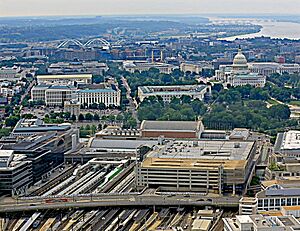
The station reopened in its current form on September 29, 1988. The old "Pit" area was turned into a movie theater. Later, it became an expanded food court and a Walgreens store. The food court still has the original arches where trains used to park. Many shops opened along the Concourse and Main Hall. A new Amtrak terminal was built behind the original Concourse. Trains no longer enter the original Concourse, but the old, fancy gates were moved to the new passenger area.
In 2012, Amtrak announced a huge $7 billion plan to update the station over 15 to 20 years. They want to double the number of trains and triple the number of passengers. They hope the government will pay for most of it. In 2015, a plan was released to guide how to preserve and restore the station.
Recent Challenges and New Plans
In the late 2010s and early 2020s, Union Station saw fewer restaurants and stores. This was especially true after the COVID-19 pandemic. Many businesses closed, and Amtrak even moved its main offices out of the station in 2017. In 2022, The Washington Post reported that over half of the commercial space was empty. The station also faced issues with homeless people staying around the building.
In 2022, Amtrak began working to regain control of the station. They have big plans for renovation and expansion. Their "Second Century Plan" aims to triple passenger capacity and double train capacity. This plan also includes "Burnham Place," a new development with shops and homes built over the existing train yard. This will connect the station to nearby growing neighborhoods like NoMa and the H Street Corridor.
Architecture of Union Station
Architect Daniel H. Burnham and Pierce Anderson were inspired by many architectural styles. They used ideas from Classical buildings like the Arch of Constantine (for the outside) and the Baths of Diocletian (for the inside). The station was placed perfectly where two of Pierre Charles L'Enfant's avenues meet. It faces the United States Capitol, which is only five blocks away.
The station is huge, with a front that stretches over 600 feet. The waiting room ceiling is 96 feet high! It features stone carvings and allegorical sculptures in the Beaux-Arts style. Expensive materials like marble, gold leaf, and white granite were used.
Above the main entrance, there are six huge statues created by Louis St. Gaudens. These statues are called "The Progress of Railroading." They show the excitement and confidence of the American Renaissance period. The statues represent:
- Prometheus (for Fire)
- Thales (for Electricity)
- Themis (for Freedom and Justice)
- Apollo (for Imagination and Inspiration)
- Ceres (for Agriculture)
- Archimedes (for Mechanics)
St. Gaudens also made 26 statues of "centurions" for the station's main hall. These large plaster statues look like ancient Roman soldiers. They are seen as protectors, guarding everyone who passes through Union Station.
Burnham wanted the station's entrance to look like a triumphal arch, similar to London's Euston railway station. He connected the main parts of the building with long arched walkways. These walkways used special lightweight, fireproof tiles. The design was also inspired by the World's Columbian Exposition of 1893 in Chicago. The way Union Station is set, with avenues leading to it in a park-like area, is a great example of the "City Beautiful" movement.
The station used to have many services, including dining rooms, barber shops, and even a mortuary. The presidential suite is now a restaurant.
Services at Union Station
Train Services
Union Station is served by Amtrak's fast Acela Express trains and Northeast Regional trains. It also serves several of Amtrak's long-distance trains. These include the Capitol Limited, Crescent, and Silver Service trains. From Union Station, Amtrak trains go to the Southeast and Midwest. Destinations include Chicago, Charlotte, New Orleans, and Miami. In 2011, over 13,000 passengers used Amtrak trains here every day.
The station is also the end point for commuter railways. These trains connect Washington to Maryland and West Virginia (MARC) and Northern Virginia (Virginia Railway Express).
The station has tracks on two levels:
- Ground Level: Tracks 7–20 (tracks 1–6 no longer exist). These tracks have high platforms, making it easy to get on and off trains. All MARC commuter trains use these tracks. Also, all Amtrak Acela Express trains and Northeast Regional trains that end at the station use them. These tracks only serve trains coming from and going north.
- Lower Level: Tracks 22–29. These tracks have lower platforms. All VRE trains use these, as do most Amtrak long-distance trains. Northeast Regional trains that continue south to Virginia also use these. Unlike the upper tracks, these lower tracks go through tunnels under the station and Capitol Hill. Electric trains cannot go through these tunnels because the electric lines end at the station. So, electric engines are swapped for diesel engines for trains going south.
Public Transportation
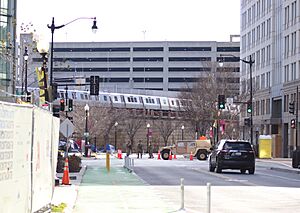
A nearby Washington Metro station connects to the Red Line subway. The Metro station is underground on the west side of the building. You can enter it from inside Union Station, from the train platforms, or from outside on Massachusetts Avenue NE.
Buses from the DC Circulator system stop at the station. These buses connect to areas like Georgetown.
The DC Streetcar's H Street/Benning Road Line also serves the station. The streetcar stop is on the H Street Bridge, just north of the station. You can get to it through the station's parking garage.
Intercity Buses
Since 2011, major intercity bus companies operate from Union Station's parking garage. These include Greyhound Lines, BoltBus, Megabus, Peter Pan Bus Lines, and OurBus. This makes Union Station a central spot for bus travel too.
Train Maintenance
The Ivy City Yard, located just north of Union Station, has a large Amtrak maintenance facility. This is where high-speed Acela trains are maintained. Amtrak also does maintenance work for MARC's electric trains. You can see part of the Ivy City Yard from the Metro Red Line between Union Station and Rhode Island Avenue Station.
Who Owns Union Station?
Union Station is owned by Amtrak and the United States Department of Transportation (DOT). The DOT owns the station building and parking lots. Amtrak owns the platforms and tracks through its company, the Washington Terminal Company.
A non-profit group, Union Station Redevelopment Corporation, used to manage the station. However, a company called Ashkenazy Acquisition Corporation has an 84-year lease on the property. It is managed by Jones Lang LaSalle.
Images for kids
-
Union Station in 1906 before its opening. Notice the absence of the Columbus Fountain
See also
 In Spanish: Union Station (Washington D. C.) para niños
In Spanish: Union Station (Washington D. C.) para niños
- Freedom Bell, American Legion, an artwork installed in front of Union Station
- List of busiest railway stations in North America
- Norwegian Christmas Tree in Washington, D.C.



